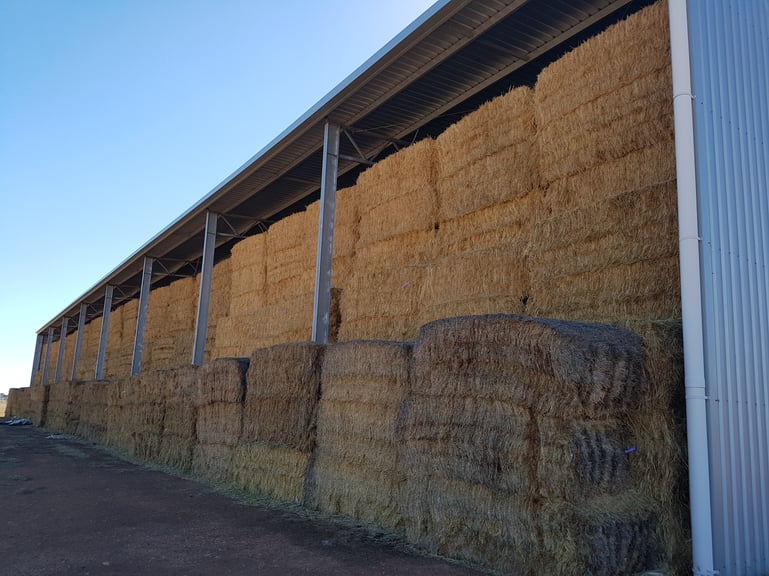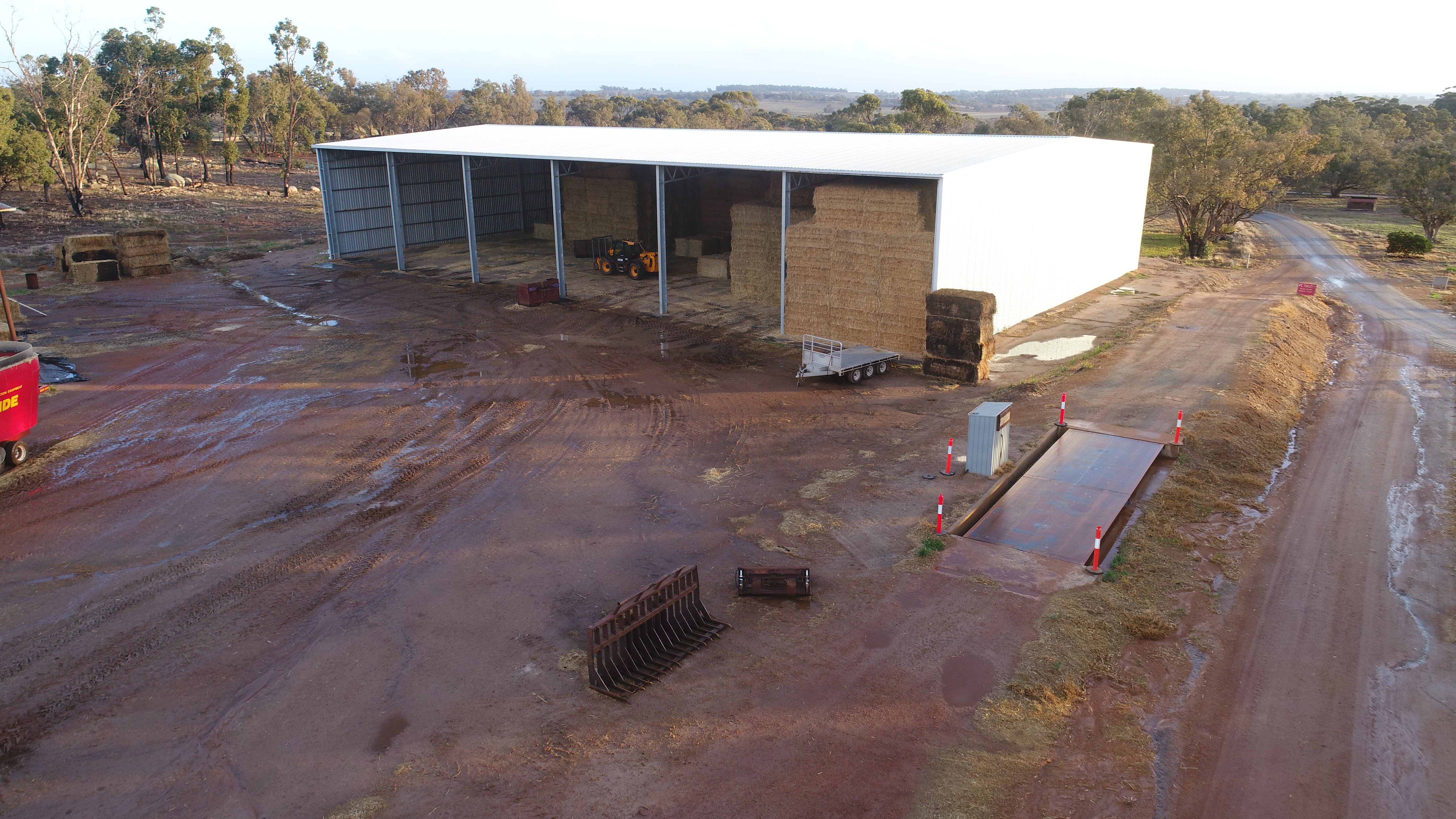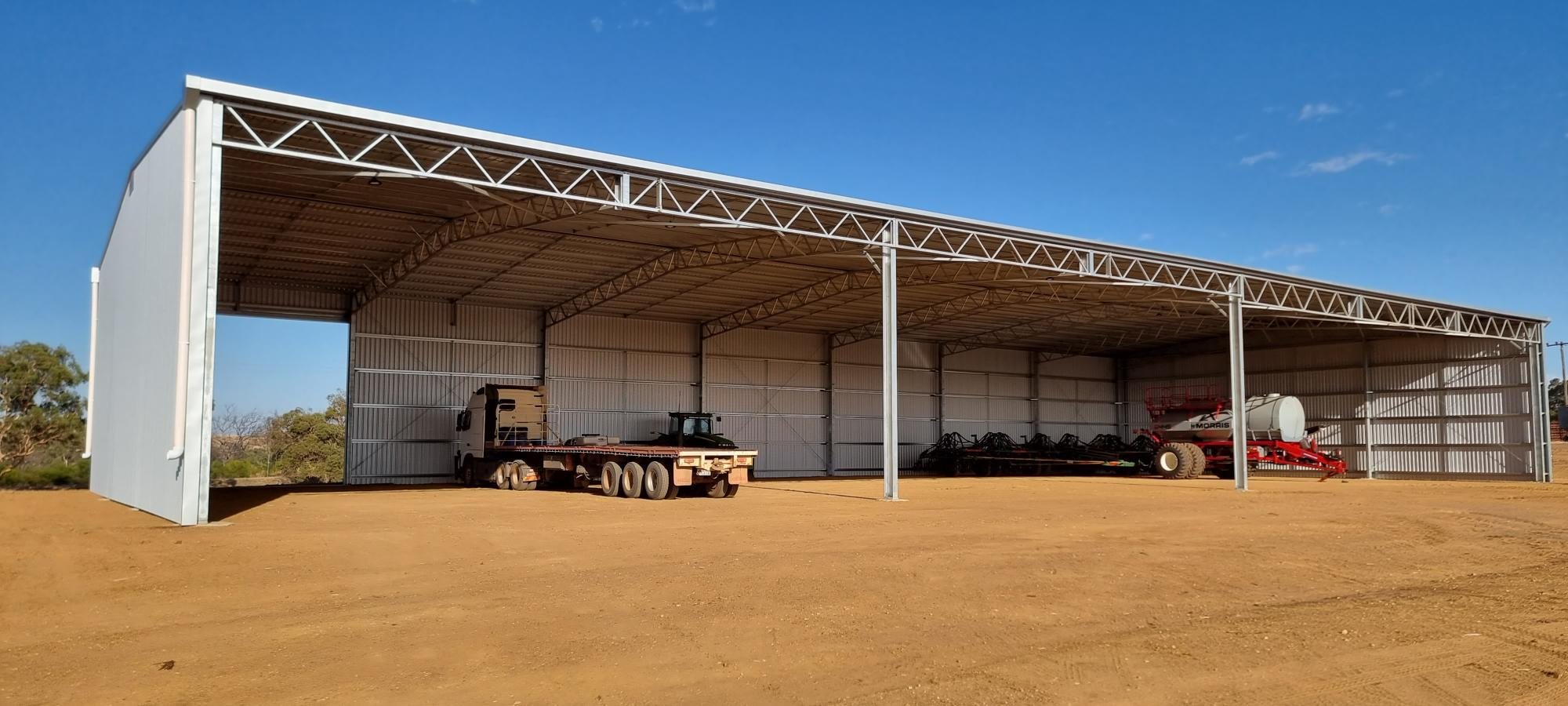
Farming and agriculture comes with its fair share of challenges and excitement. One such undertaking is the construction of a hay shed. A crucial storage solution for safeguarding your produce, a hay shed plays an indispensable role in maintaining the quality of stored hay, thereby directly impacting profitability, the health of your livestock and overall farm productivity. If you're on the brink of organising your hay shed build, there are pivotal aspects you need to consider to ensure durability, efficiency, and value for money. Dive in as we uncover the essential considerations to keep in mind.
How to determine sizing requirements to fit your stored hay bales and machinery
Determining the appropriate size for your hay shed is crucial to ensure not only the storage of hay bales but also any machinery or equipment you might want to keep there. Here's a general insight:
Estimate hay volume
- When embarking on the journey of building a hay shed, the first step is to get a clear picture of the volume of hay you aim to store. This volume largely depends on your farm's hay crop size and how frequently you intend to utilise or sell the hay. Additionally, the type and size of your bales play a pivotal role in spatial planning. Small square bales will have different storage requirements compared to large square or round bales.
Incorporating machinery and equipment
- Machinery storage often becomes a secondary thought, but it's vital to the process. If your vision for the shed includes housing equipment such as tractors, balers, or loaders, you'll need to factor in their dimensions. This isn't just about length and width but also height, especially if they come with tall attachments. Moreover, it's essential to add some buffer space for ease of movement and maintenance.
Designing for access and airflow
- Designing your hay shed isn't only about maximising storage; it's also about accessibility and the quality of storage. Aisles between haystacks are imperative. These spaces not only simplify access but also encourage better air circulation, reducing mould risk and ensuring hay longevity. When planning these aisles, consider the manoeuvring space required for machinery, ensuring a balance between efficient storage and safety.
Futureproofing your shed
- Agriculture is an evolving enterprise, and so is the need for storage. When organising your hay shed build, think long-term. If you anticipate a growth in production or the introduction of more machinery, your design should either accommodate that growth from the outset or be flexible enough for future expansion.
Safety, storage duration, and professional consultation
- Safety always comes first. Whether it's the height to which you stack the hay or the circulation space for machinery, every design decision should prioritise safety. Furthermore, your shed size should reflect not just your current needs but also account for prolonged storage durations, especially if you have varying harvest cycles. Lastly, while personal research and planning are invaluable, consulting with experienced agricultural shed builders or professionals can offer tailored insights and refine your vision.
Consider the sun, wind, and ground suitability
- The sun, wind and ground suitability are all crucial environmental factors to consider when planning and organising your hay shed build. These elements can significantly influence the longevity of your stored hay, the stability of your structure, and the overall functionality of your shed.
Sunlight's role in shed positioning
- The sun's position and its trajectory can significantly influence the conditions inside your hay shed. When determining the orientation of your shed, it's imperative to gauge the daily and seasonal sunlight patterns. In areas prone to intense heat, positioning the shed to minimise direct sun exposure can be beneficial in maintaining the hay's quality. Additionally, incorporating roof overhangs in the design can offer further protection, providing shade and reducing potential overheating inside the shed.
Harnessing the wind for ventilation and stability
- Wind, while often overlooked, plays a dual role in the design and positioning of a hay shed. On one hand, leveraging prevailing winds can promote natural ventilation within the structure. Proper airflow is crucial in hay storage, as it curtails moisture accumulation, mitigating the risks of mould and spoilage. On the other hand, in regions with strong wind patterns, the shed's design must prioritise stability. This might mean deeper foundations, additional bracing, or specific aerodynamic considerations to ensure the shed stands firm against gusty challenges.
Ground suitability: the foundation of it all
- The ground on which your shed will stand requires meticulous evaluation. A level ground ensures uniform weight distribution and enhances the shed's structural stability. If the land is uneven, consider investing in levelling or grading to create a suitable base. However, beyond levelling, drainage emerges as a critical concern. Moisture can be the bane of stored hay, so ensuring the site facilitates efficient water runoff is paramount. This might make elevated or gently sloping sites more desirable. Additionally, the soil type can dictate foundation requirements. While sandy soils might demand deeper foundations, clay-rich terrains, with their moisture-retentive properties could necessitate specialised drainage solutions.
Ensuring environmental harmony and accessibility
- While understanding and accommodating the individual roles of the sun, wind, and ground is essential, it's equally important to view the hay shed in the larger context of the farm ecosystem. Consider its relationship and proximity to other farm structures. For example, positioning the hay shed should not inadvertently deprive nearby sheds or livestock areas of vital sunlight or airflow. And amidst all these environmental considerations, accessibility remains key. Your shed should be easily approachable for machinery, transport, and routine operations, striking a balance between nature's demands and practical agricultural needs.
How long do hay shed builds take, and what sort of costs should I be expecting?
Building a hay shed is a significant project that involves planning, sourcing materials, construction, and finishing touches. The time and cost associated with such a build can vary widely based on a multitude of factors.
Building a hay shed involves multiple stages, each contributing to the overall duration of the project. The initial time is dedicated to meticulous planning, design finalisation, and the often time-consuming permit acquisition process. This phase is followed by site preparation, which may include land clearing and levelling. The subsequent steps involve laying the foundation, erecting the structural framework, and installing roofing and walls, collectively spanning several weeks.
Concluding the build involves adding finishing touches, such as ventilation, doors, and vertical bale supports. It can be tricky to provide an actual timeframe, as the build process can always be affected by variables like weather conditions, material availability, labour, and the aforementioned permit acquisition process.
Financially, hay shed construction is a sizable commitment. Initial expenses are incurred during the planning and design stage, which can vary from a few hundred to several thousand dollars. Site preparation, influenced by the land's condition, and foundational work form significant portions of the budget. Material costs for roofing, walls, and other structural components can fluctuate, based on quality and size considerations. Labour, an essential cost component, is influenced by regional rates and the complexity of the project.
Lastly, additional features, from doors to ventilation systems, add to the overall expenses. Just as it can prove tricky to provide set timelines, it can also be problematic to provide budget amounts, especially because the size of hay sheds varies greatly, which has an obvious effect on cost. One point we would emphasise however is the importance of detailed budgeting and contingency planning.
Hay shed permits and regulations
Ensuring compliance with local regulations and obtaining necessary permits is crucial when planning any construction, including a hay shed. These rules ensure the safety, sustainability, and harmony of infrastructures within a community.
Zoning laws & their implications
Before you even set foot on the construction site, it is imperative to understand the zoning laws that govern your property. Different regions have distinct classifications, and each comes with its set of rules about permissible structures. For instance, while one zone might freely allow agricultural structures, another might restrict them based on size or use. Along with zoning, you will encounter the concept of setbacks. Essentially, these rules dictate how far your hay shed must be from property boundaries, roads, or other structures. This ensures that farm buildings maintain a safe distance from each other, allowing for adequate accessibility and reducing risks of cross-contamination or fire spread.
Building codes: safety & sustainability
Every region adopts building codes that ensure the structural integrity of any new construction. For hay sheds, these codes guarantee that the design can endure local environmental pressures, be it high winds, or seismic activity. Beyond the structural aspects, building codes often delve into the materials used in construction. Depending on the region's specific concerns such as fire hazards or sustainability goals you might find regulations governing the kind of cladding, or other materials you can use.
Protecting the environment & conservation
In the age of environmental consciousness, many regions have instituted regulations to protect natural resources. If your chosen construction site is near water bodies, you'd need to ensure that your hay shed operations don't lead to contaminating runoff. Moreover, if your property encompasses areas designated as critical habitats, there might be restrictions in place to protect local flora and fauna. These regulations highlight the importance of coexisting with nature, ensuring that farming practices don't inadvertently harm the broader ecosystem.
Staying compliant in the long run
Building your hay shed isn't a one-time event; it's a long-term investment. As such, some regions require periodic reviews or renewals of permits, especially if there's a change in the shed's use or if you plan future expansions. These reviews ensure that your structure remains compliant and safe over the years. Embarking on the journey of building your first hay shed might seem daunting with these layers of regulations. However, they are in place to ensure safety, sustainability, and harmony within the community. Engaging with local experts and regulatory bodies early in the planning process can smooth out potential roadblocks and pave the way for a successful build.
With all of your hay shed needs summed up, it is time to get moving
Building a hay shed requires meticulous planning, an understanding of local regulations, and strategic investment. Key considerations for such a venture include sizing requirements, the influence of environmental factors like sun, wind, and ground suitability, and navigating the complex landscape of permits and regulations. As for the actual build, both time and financial investments vary widely. A standard hay shed build can be influenced by stages like planning, site preparation, foundational work, and adding finishing touches. Costs for these builds are contingent on design intricacies, material choices, labour rates, and additional features. In all, constructing a hay shed demands thorough research, professional consultation, and careful budgeting to ensure a durable and compliant structure.

Am I able to customise my hay shed with auspan?
AUSPAN specialises in steel shed and building solutions, allowing for tailored designs to fit individual needs. If you are looking to customise a hay shed, we offer a variety of options. You can choose specific materials, customised bay spacing, clearance heights etc. To suit your bale sizes and stacking plans, ensuring the durability and functionality of your hay shed. AUSPAN's approach emphasises client collaboration, which ensures any additional customisations are made entirely to suit your specific requirements.
 sales@auspangroup.com.au
SEND US A MESSAGE
sales@auspangroup.com.au
SEND US A MESSAGE
 1300 271 220
CALL US
1300 271 220
CALL US





-1.png)